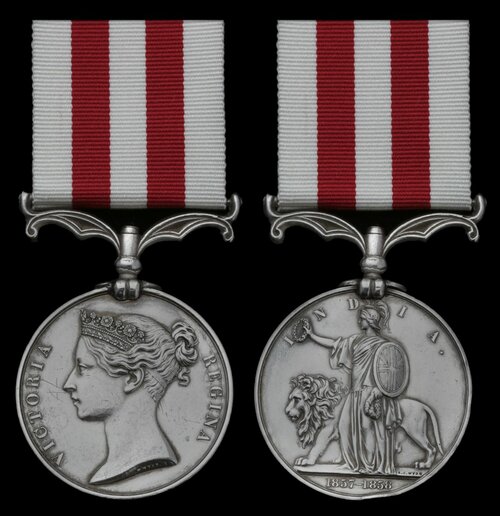
Auction: 22001 - Orders, Decorations and Medals
Lot: 328
Indian Mutiny 1857-59, no clasp (James Stephens No. 3 Indian Naval Brigade), very fine and light collector's mark in field
Ex-Douglas-Morris Collection, October 1996.
James Stephens served in No. 3 Detachment, Indian Naval Brigade, the third Naval Brigade to be involved in suppressing the Mutiny. Like the previous two, it started life at Calcutta. Some 2,000 non-Indian officers and men were drawn from the ships Assaye, Semiramia, Ajdaha, Punjab, Zenobia, Coromandal and Auckland, under the administration of Captain D. C. Campbell. The Indian Naval Brigade's ten detachments, each comprising about 200 men, served in different theatres. For example, No. 4 Detachment, from the steam frigate Punjab, attacked and disarmed the 73rd Bengal Native Infantry at Dacca, in what is now Bangladesh. Midshipman A. Majo, aged just 17, led the charge against these mutineers and was awarded the Victoria Cross.
In his diary, Naval Cadet E. S. Watson of the Shannon recorded that in mid-October part of the Indian Naval Brigade was based at Dinapore, on the Ganges. It then proceeded upstream to Benares, for service on the River Gogra. Interestingly, Watson mentioned that the Indian Naval Brigade went up that river 'in their gunboat', which suggests that in addition to fighting on land, these versatile Bluejackets also patrolled the waterways in support of the Trans-Gogra Expedition (see previous Lot). It is not known which detachment of the Indian Naval Brigade Watson was referring to; it might have been No. 3 Detachment.
Either way, the unit were engaged in the action at Jehanabad, above Allahabad, on 22 August 1857, and at the two affairs at Doomraon in August and October 1858. Stephens was discharged from the service on 4 April 1859.
Subject to 20% VAT on Buyer’s Premium. For more information please view Terms and Conditions for Buyers.
Sold for
£800
Starting price
£550




